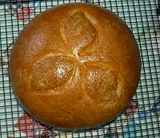Completed the Artos Greek Celebration Bread yesterday morning:
[URL=http://s304.photobucket.com/albums/nn169/topturner/?action=view¤t=GreekCel3.jpg] [/URL]
[/URL]
[URL=http://s304.photobucket.com/albums/nn169/topturner/?action=view¤t=GreekCel10.jpg] [/URL]
[/URL]
(CLICK IMAGES FOR LARGER VIEW)
The recipe recommends turning the loaf 180 degrees about 20 minutes into the baking time. I found that the gelatinization was incomplete at that point in time and, in moving the baking sheet, I bumped it slightly and "jiggled" the elastic mass. Prior to that I had a fantastic oven spring. Appeared to me that I lost about 10% of that feature from that action.
Advice: If you turn the loaf as recommended, do it VERY gently. Sliding it on the oven rack is probably better than picking the baking sheet up and setting it back down after making the turn.
Although I did have the baking stone in the oven to help maintain consistent levels of heat, I didn't bake the loaf on it. I had the loaf on silpat on a metal cookie sheet. I used that method because if seemed a better method of preparation for turning the loaf at baking mid point.
Started with a 400 degree preheated oven (20 minute preheat) and loaded the loaf at that temperature, then reduced temp. to 350 after 5 - 7 minutes. Total baking time to 195 degrees was 35 minutes.
Recipe adjustments:
Increased initial oven loading temperature to maximize oven spring.
Used the typical boule stretching technique for stretching of surface in final shaping for final rise.
Used Active Dry Yeast in place of Instant Yeast at 1.36/1 ratio
Slashed the loaf to enhance expansion
Finish is plain water/honey glaze.
Crumb was excellent, texture was very good, flavor wonderful. Notice at the bottom of the loaf there is a dark area which is the area of compression I experienced as the loaf relaxed from its oven spring size as it was rotated at the 20 minute point in baking. This small section is more dense than the rest of the crumb but it is not uniquely detectable to palate.
I might have avoided this by either turning the loaf as recommended but more gently (it was on a silpat layer atop a cookie sheet) or by loading it directly onto the stone so that the bottom of the loaf baked more quickly.
How did you create the design on your Artos? I really like it.
David
Once the loaf had finished it's final rise I used the blade from a box cutter (held in the hand without the typical holder) with the blade held almost flat with just enough "life" at one end to prevent it from digging in to the dough. I started at the center of the loaf and cut an arc, then returned to the starting point and cut a complientary arc. I just repeated that process two more times at 120 degree angles to complete the design.
I got that exact same 'compression' spot in my loaf. I baked mine with the poolish version and didn't glaze it. It turned out wonderful and is fantastic as toast!
Thank you for the report, raidar. You have me thinking that, perhaps what I saw as 'compression' in my loaf was not, as I originally thought, the result of degassing when I turned it in the oven. I'll watch for that more closely next time. I had some more of that loaf for breakfast this morning; OMG it's good. Glad to know yours worked out well for you also.